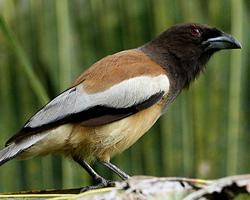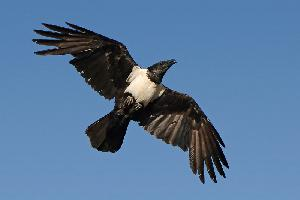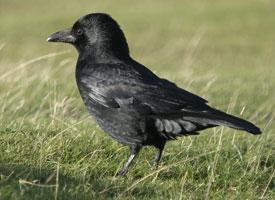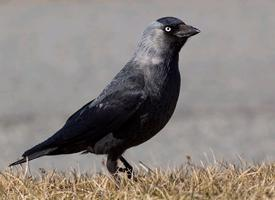
Statut de conservation
| Intrépide |
Description de l'animal
The Rufous Treepie (Dendrocitta vagabunda) is a striking bird species belonging to the crow family, Corvidae, known for its remarkable intelligence and adaptability. This bird is native to the Indian Subcontinent and adjoining parts of Southeast Asia, thriving in a wide range of habitats from dense forests to urban areas. The Rufous Treepie is distinguished by its vibrant plumage, melodious calls, and curious nature, making it a fascinating subject of study and observation in its natural environment.Physical Description:
The Rufous Treepie is a medium-sized bird, measuring about 46 to 50 cm in length, including its long, graduated tail which is longer than its body. The bird exhibits a striking color palette; its upper parts are primarily rufous or cinnamon, blending beautifully with a black head and neck. The bird's underparts are a softer, paler shade of rufous, creating a stunning contrast with the darker upper parts. The wings are black with a white patch, and the tail is long and graduated with a broad, white tip, making it easily recognizable even from a distance. The bill is stout and hooked, perfectly adapted for its omnivorous diet, and is a distinctive bluish-grey color, complemented by bright, keen eyes.
Habitat and Distribution:
Rufous Treepies are versatile in their habitat preferences, ranging from dense forests to urban gardens and everything in between. They are predominantly found throughout the Indian Subcontinent, including India, Nepal, Bhutan, Bangladesh, and parts of Pakistan. Their range extends into Southeast Asia, covering regions in Laos, Cambodia, and Vietnam. These birds adapt well to human-altered landscapes, often seen in cultivated areas and near human habitation, where they are known to interact with humans.
Behavior and Diet:
The Rufous Treepie is an omnivorous bird, with a diet that includes fruits, seeds, insects, small reptiles, and the eggs and young of other birds. They are known for their intelligence and have been observed using tools in captivity, a trait common to members of the Corvidae family. These birds are also known for their boldness, often approaching humans closely, especially in areas where they are accustomed to being fed.
The Rufous Treepie is highly vocal, with a wide range of calls that are melodious and sometimes harsh. Their calls are an integral part of the auditory landscape of their habitat, and they often participate in mixed-species flocks, leading the chorus of the forest. They are also known for their mimicry abilities, imitating the calls of other bird species.
Reproduction:
Breeding season for the Rufous Treepie varies by region but generally occurs just before the onset of the monsoon. They build their nests high in trees, which are made of twigs and lined with softer materials. The female typically lays 3-5 eggs, which are incubated for about 14-15 days. Both parents participate in feeding and caring for the young, which fledge approximately 3 weeks after hatching.
Conservation Status:
Currently, the Rufous Treepie is classified as Least Concern by the International Union for Conservation of Nature (IUCN), indicating that it is widespread and abundant across its range. However, like many species, it faces threats from habitat destruction and fragmentation. Despite these challenges, the Rufous Treepie's adaptability and generalist lifestyle have allowed it to thrive in a variety of environments.
In summary, the Rufous Treepie is a fascinating and adaptable bird, known for its striking appearance, intelligence, and sociability. Its presence enriches the biodiversity of its habitat, making it a cherished member of the ecosystems it inhabits.
Animaux similaires
Nouvelles photos d'animaux
Top 10 des animaux
- Dolphin gull (Leucophaeus scoresbii)
- Diana monkey (Cercopithecus diana)
- Moustached guenon (Cercopithecus cephus)
- Galápagos tortoise (Geochelone nigra complex)
- Japanese macaque (Macaca fuscata)
- Stone loach (Barbatula barbatula)
- Russian tortoise (Testudo horsfieldii)
- Greek tortoise (Testudo graeca)
- Common flying dragon (Draco volans)
- Vendace (Coregonus albula)


